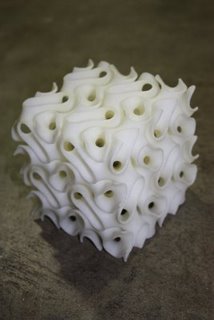First, a series of computer models were generated by computer algorithms, cellular automation, and mathematic equations using Maya and Houdini programs. These computer models were fabricated as physical prototypes by the Stratasys FDMTM (Fused Deposition Modeling) systems, CNC machine, and laser cut machines available at SCAD. The purpose of this part is bi-fold. It does not only inspire designers for the use of unconventional 3D forms in architectural design, which has traditionally been restrained by difficulties in design and visualization, but also tests the possibility of these unconventional 3D forms in being manufactured as physical prototypes.
This confirms again our opinion that there are no limits to our creative power. Shed the chains of reality!
Via Morphism Design and MathMorph



this model is also two separate units that were printed together. they are interlocked together and can move independently from one another.
This is the beginning research into a project that will be looking at transforming traditional CMU architecture building blocks. Right now we, mathmorph, are beginning with cubes. As I move forward with the project i am looking at how these forms morph and populate a surface. It is there where the project moves past the traditional Bathsheba cube and moves into a conceptual idea. More will be posted as the project moves forward. here is an example of where the project may move into. http://morphismdesign.blogspot.com/2009/07/populating-surface.html
– Jonathon Anderson
It's not news; we just thought it was interesting.
So, it's a http://www.bathsheba.com/“ rel=”nofollow”>bathsheba clone, three years after the fact? How is this news?